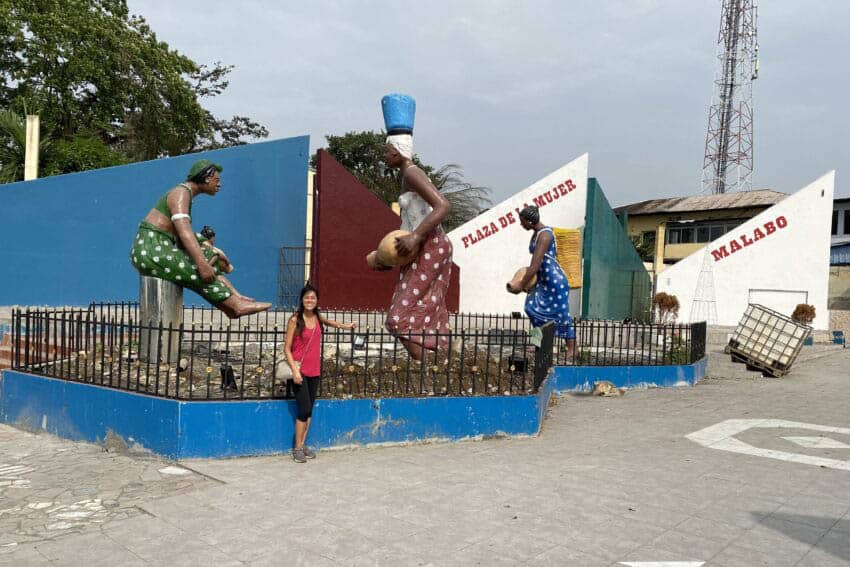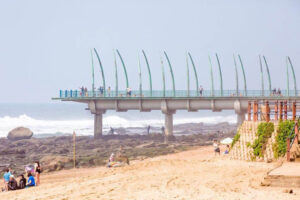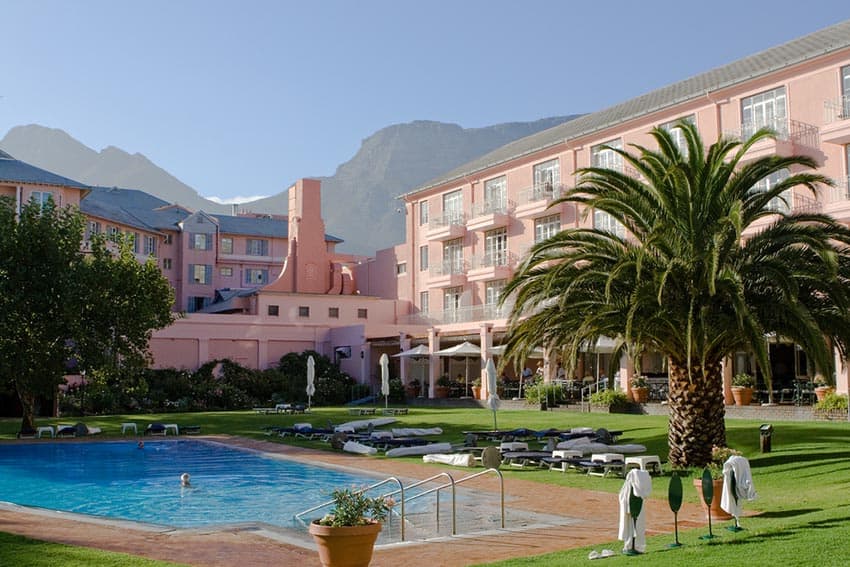
Mount Kenya Lacks Kilimanjaro’s Fame But is a Worthy Trek Indeed
By Cameron Fergus
Beyond the shadow of Kilimanjaro lies a mountain with all of its neighbor’s glory but little of its fame. Cameron Fergus treks Mount Kenya and reveals the true light at Africa’s fabled heart.
On Mount Kenya, it is the silence that gets you. Between the park gates and the glacier-encrusted summits lies impenetrable jungle, chilly shrub-covered moorlands, an alpine forest, and an all-embracing silence that was so unexpected.
Like a giant open-air cathedral, it is a place that encourages whispered thoughts and quiet contemplation. More than simply a jagged mountain range on the far horizon, Mount Kenya is also the spiritual heart of the East African nation that bears its name.
The second-highest massif on a continent often regarded only for darkness, Mount Kenya stands proud and defiant, its shimmering peaks a beacon of brightness at Africa’s core.
Mount Kenya awaits
“Twende?” (“Ready?”) “Mount Kenya is waiting.” Isaac our guide, a Kikuyu tribesman from Kenya’s west, was keen to get moving. Far from his home near Lake Nakuru, he was commencing yet another assignment that would have him away from his wife and two young daughters for a long stretch.
“I love to guide clients on these mountains, especially Mount Kenya,” he explained, his genuine affection for his work becoming clear, “but of course I love my daughters more.”
It had been a long tourist season, with too many days spent away from home. “But of course they wait for me to climb the mountain again. So let’s go. But walk quietly, take your time, and enjoy the mountain.”

It was a genuine insight into Isaac’s life balancing his roles as a guide, father, and husband, and a timely reminder of the sacrifices that other people often make in order to show us their world.
Entering the forest our group – three trekkers, Isaac, and four porters – fall into line along the trail fringed with bright yellow wildflowers and long, hardy tussock grasses, walled in by a great green thicket of shrubs and heather.
Towering over the Forest Floor
Rising from out of the rapidly thickening hedge, giant fig and cedar trees tower more than 20 meters over the forest floor, their resident birdlife providing the only soundtrack to the scene.
The air is a pungent fusion of all this undergrowth, combined with the humidity of the tropics, shot through with the ever-present alpine breeze.
The whole place is overgrown with vines, mosses, lichens, and other invaders, an impenetrable wall of vegetation growing over, around, and above one another. This is no well-ordered Garden of Eden, it is a rampant jungle as wild as its inhabitants.

Encompassed in a silent world created by thick walls of bush on all sides, the slightest sound – trees creaking in the gathering breeze, the snapping of twigs and branches – could mean anything. Our senses fully engaged, absorbed by the wildness of Africa, we are driven by the most primal of instincts: survival.
Evidence of wildlife is all around: great fresh balls of elephant dung lie steaming in the chilling late afternoon air; while lion and leopard scat along the trail is a frequent reminder that the big cats still stalk the slopes of this mountain. It is those moments – the excitement and the fear of being in a truly wild country – that Africa delivers in spades.
The peaks and valleys
Early on the second day, we ascend a ridge to find the wide expanse of the Mackinder Valley opening up before us, sealed at the far end by the massive forms of the mountain’s main peaks Nelion and Batian. The peaks are a dark, brooding, and overwhelming mass of jagged rock and ice which, until now, remained hidden behind heavy clouds.
“This is nothing,” suggested Isaac. “On the way down the view is much better.”
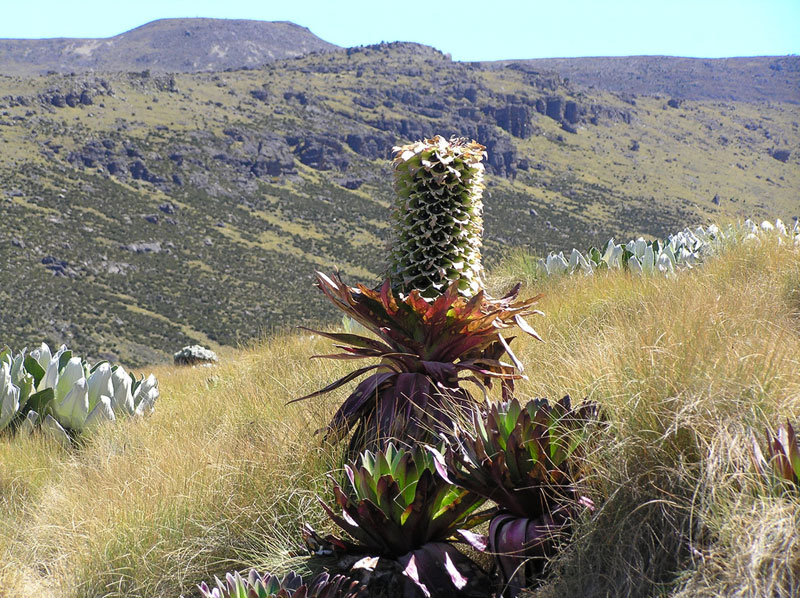
To the northwest, the sharp V-shaped valley walls carved out by the meltwater from glaciers over millennia, twisted and turned toward the distant lowlands. To the southeast, the mountain range itself: serrated, black and silver, its glaciers shining in the morning sun in defiance of their tropical location here on the Equator. No Isaac, this is not “nothing.”
Trekking for the entire day along the Mackinder Valley reveals the truly unique inhabitants of this mountain. Giant Groundsel trees and Ostrich Lobelia – more like great vertical feather boas than mountain flora – dominate the valley walls.
Eagles soar high above, observing our progress, and Rock Hyraxes scurry in all directions as we shuffle into Shipton’s Camp.
Standing beneath the summits, at the end of a long trekking day (the second day that we’ve not seen a single other person on the trail), porter Mwangi and I watch thick, dark, ominous clouds blow across the mountain range and down into the valley.

With a momentarily clear view of the peaks, I refer to the mountain as ‘Kirinyaga,’ a name that the Kikuyu tribe has traditionally used when referring to Mount Kenya.
The Kikuyu regard this place as the sacred home of their god and build their houses with the doorways facing the mountain so that it is the first thing they see when they rise and the last when they retire for the night.
But I was to learn that Kirinyaga is a name that is frowned upon in wider company. “No, we do not use that name, we only call it Mount Kenya,” asserted Mwangi. “There are more than forty tribes here and the mountain belongs to all of us, not only one tribe.”
The look on Mwangi’s face communicated more than his words ever could. I had inadvertently stumbled across an issue that was far more sensitive than I could understand.
Kenya has a rich and robust culture, its tribal populations supplemented by significant Indian, British and Arab groups. And while the mountain unites all, Mwangi’s comments revealed that it is a sometimes-fragile union.

The roof almighty
“Jambo, it is time.” Isaac’s wake-up call at 2:00 a.m. on the morning of our summit attempt came after a few restless hours of little sleep. Even before I had started, my mind was exhausted from trying to anticipate the challenge ahead. The combination of excitement, altitude, bitter cold, and lack of sleep, left me questioning the sanity of this adventure.
The hot tea prepared so generously by our porters at this stupidly early hour did nothing to quell the churning in my stomach and the gale blowing outside the hut was hardly reassuring. The only solution was to tie my boots, struggle into the layers of clothing packed for exactly this occasion, and head out into the darkness to meet the mountain on its own terms.
Point Lenana
While Nelion and Batian are the true climbing summits, most trekkers opt summit at Point Lenana which, while requiring no technical climbing expertise, is a momentous challenge in its own right and at 4985m merely 200m lower than the high point of Batian.
Trekking in total darkness, a head torch providing only pitiful illumination of the frozen scree and small boulders ahead, there is no indication of direction, incline, or altitude and a sleepy mind is of no assistance.
It is simply one labored step after another, for hours. With the sun beginning its rise we had completed much of the hard work, with only another hour’s climbing – now using gloved hands as well as freezing feet – to Point Lenana.
The brightening cliff faces revealed an intricate network of crags, cracks, and ledges ahead as well as a group of impossibly blue tarns (mountain lakes) behind us that we had shuffled past during the night, oblivious to their existence so close to the trail.

Reaching Point Lenana with its frozen Kenyan flag and a small crowd of early rising trekkers backlit by the early morning light justified the exhaustive effort we’d just undertaken in the dark.
Nelion and Batian, now the smallest that they would ever be for us, we’re only a short distance away across the brilliant white Lewis Glacier, the contours and channels etched into its surface like the lines on the back of aged hands.
And further away across the perfectly clear horizon was Kilimanjaro, massive even from this distance, its own volcanic peak as flat as Mount Kenya’s are jagged.
“We are very lucky,” reminded Isaac. “Not everyone can say that they have seen Kilimanjaro from the top of Mount Kenya.”
I try to take it all in, to remember it entirely, but the cold is biting savagely and the freezing oxygen-poor air refuses to provide anything resembling a sustaining breath.
“Come,” said Isaac, breaking us too soon from this moment, “I promised to show you something even better than the Mackinder Valley. But we must follow the trail to the other side of the mountain to see it.” And despite believing it couldn’t get better, he is right.

We sit, legs dangling, on the edge of a sheer thousand-foot drop, gazing for miles along the Gorges Valley. The valley is defined on both sides by great vertical cliff faces – ragged black and green parallel walls of rock – which sweep down to the plains below.
The severity of the slopes ease as they eventually come together at the base of the valley, and here sits the still, blue, teardrop-shaped Lake Michaelson. The picture is a contrast of silence and wildness, of the calm and the brutal forces that typify this whole mountain landscape.
The conversation is quiet and sparse, words are redundant up here. It seems impossible now, even if I travel for the rest of my days, that I will ever see anything to compare to this.
On our last morning, we reluctantly trooped out of camp and dropped into the valley as the first signs of vegetation re-appear. The forest was slowly revealed over the ensuing hours with the Black and White Colobus Monkeys in the canopy the first signs of wildlife that we have seen since the hyraxes at Shipton’s, seemingly weeks ago.
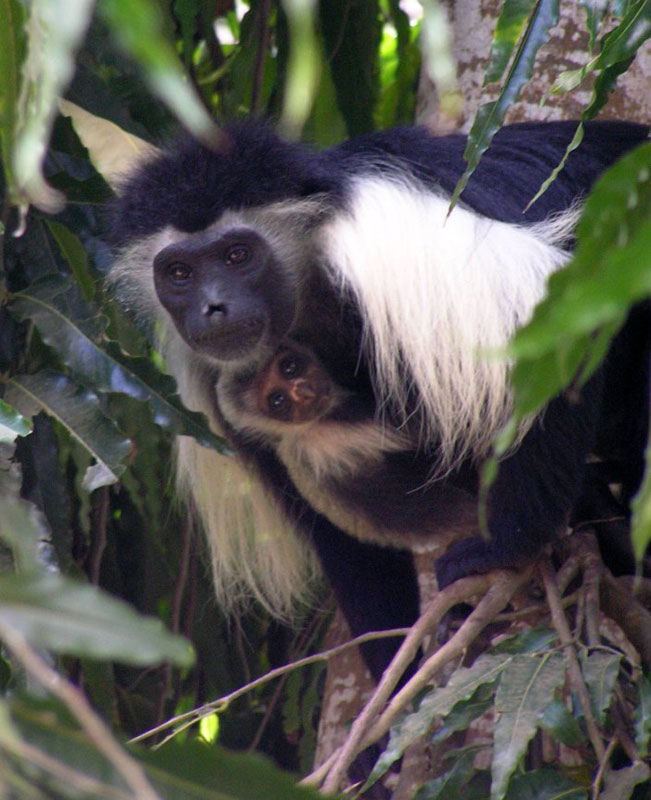
Across a clearing eland graze — the largest of all African antelope — with the huts and the end of the trek in the distance.
A swarm of African bees catches us off guard and we’re floored, spread-eagled on the dusty track, until this buzzing cloud clears. It serves to release the emotion of the moment — the melancholy we’re all feeling at having climbed the mountain but now with the end of the adventure in sight — and we arrive, a laughing rabble, into camp.
The heart of brightness
Later we sit with a group of rangers on the porch of the park warden’s hut watching the great grey wrinkly form of an elephant slowly shuffle out of the bamboo forest. It is our first elephant of the trip, on our last day. Mount Kenya has delivered again.
It is clear why this mountain is held in such reverence by all Kenyans, for its beauty as much as for the sacred place it holds in their lives.
Discussion in camp soon turns to which of the great African mountains is best. Both have so much in common but are so markedly different and individual.
Perhaps it comes down to taste. If bigger is truly better then Kilimanjaro is your choice, but if you want to explore the beauty of a mountain virtually on your own, then Mount Kenya’s the one.
The last word goes to Isaac, a man who has spent his years climbing both mountains and is best placed to make such a decision. And with his characteristic simplicity, and as his last act before heading home to his family, he puts the issue beyond doubt: “Kilimanjaro is bigger, but Mount Kenya is brighter.”
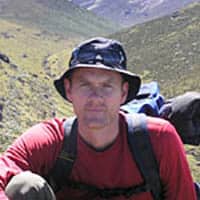 Cameron Fergus, 36, is a freelance writer and business consultant from Melbourne, Australia, who has traveled extensively through East, Central and Southern Africa, Europe and Asia, as well as the great southern land that he calls home.
Cameron Fergus, 36, is a freelance writer and business consultant from Melbourne, Australia, who has traveled extensively through East, Central and Southern Africa, Europe and Asia, as well as the great southern land that he calls home.
- These 9 U.S. National Parks Require Reservations in 2024 - April 17, 2024
- Take a Hike in Olympic National Park - April 17, 2024
- The Wild Mississippi: 2340 Miles Across Ten States - April 8, 2024


